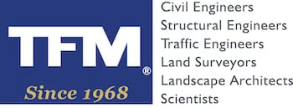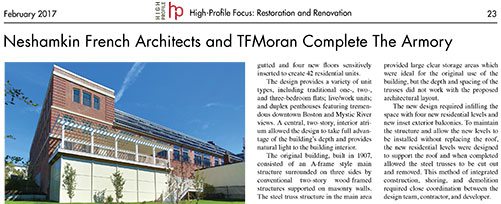TFMoran’s Chief Structural Engineer, Paul Sbacchi, PE provided structural design for the restoration and renovation of the former Charlestown Battalion Armory, originally built in 1907. This very interesting project located on Bunker Hill Street is featured in this month’s issue of High-Profile in the section “Focus: Restoration and Renovation” page 23. Read the full story below, or link to a pdf of the article here: High-Profile February 2017 features The Armory To view the entire February issue of High-Profile click here.
Neshamkin French Architects and TFMoran Complete The Armory
Charlestown, MA – Neshamkin French Architects and TFMoran Structural Engineers of Bedford, N.H., provided architectural and structural engineering services for the renovation of the former Armory building in Charlestown, Mass. into 42 luxury condominiums with underground parking.
Construction was completed by Eastridge Construction Management of North Reading, and the project was developed by Pat Keohane of C-Town Ventures LLC.
Previously underutilized, the Charlestown Battalion Armory has been revitalized through a sensitive program of historic restoration and innovative interior design. The architectural design, completed by Neshamkin French Architects Inc., preserved the exterior building envelope while the interior, including the structural system, was gutted and four new floors sensitively inserted to create 42 residential units.
The design provides a variety of unit types, including traditional one-, two-, and three-bedroom flats; live/work units; and duplex penthouses featuring tremendous downtown Boston and Mystic River views. A central, two-story, interior atrium allowed the design to take full advantage of the building’s depth and provides natural light to the building interior.
The original building, built in 1907, consisted of an A-frame style main structure surrounded on three sides by conventional two-story wood-framed structures supported on masonry walls. The steel truss structure in the main area provided large clear storage areas which were ideal for the original use of the building, but the depth and spacing of the trusses did not work with the proposed architectural layout.
The new design required infilling the space with four new residential levels and new inset exterior balconies. To maintain the structure and allow the new levels to be installed without replacing the roof, the new residential levels were designed to support the roof and when completed allowed the steel trusses to be cut out and removed. This method of integrated construction, shoring, and demolition required close coordination between the design team, contractor, and developer.


